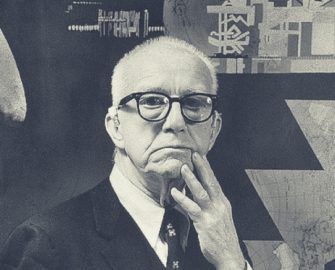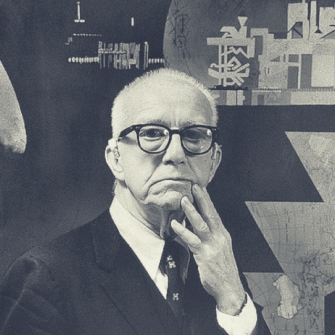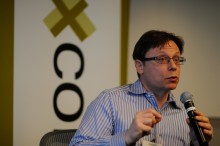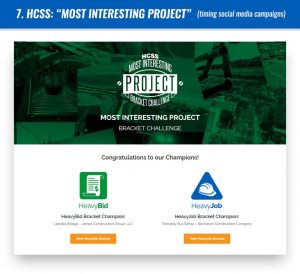On a snowy day in late 1927, a young corporate executive looked down past his toes, past the trusses of the bridge, into choppy waters of Lake Michigan. Earlier that year, his first daughter had died and he had lost his job as president of a building company.
He had no savings to fall back on, and his wife had just given birth to his second daughter. With no employment prospects and a hungry family, he had resolved to jump off a bridge so his family could get the life insurance payout. Standing on the bridge looking down, he had a realization that would define the remainder of his life.
If he was willing to end his life, he had nothing to lose by trying to live ways he had not yet imagined.
Seeing as he was already prepared to die, whatever time he had left could simply be an experiment to see what he could contribute to humanity.
That man was Buckminster Fuller, who became one of the most productive scientists of the 20th century. He published over thirty books, invented the term Spaceship Earth, as well as designing the geodesic dome.
Late in his life, he cited that moment when he began to view his life as an experiment to be the crucial turning point for what became an immensely productive life.
The Two Selves and The Scientist Mindset
Essentially, what Fuller did in that moment was divide himself into two people. There was Buckminster Fuller “The Scientist”, who now had this whole life to tinker and see if he could benefit humanity — and there was Buckminster Fuller “The Operator”, who would carry out these experiments.
This mindset of imaging yourself as two people, one being the person doing the actions and the other a scientist examining them, has recently gathered scientific backing.
Thinking Fast and Slow, the work of Daniel Kahneman and Amos Tversky, has come to serve as the bedrock of behavioral economics. It distinguishes between two systems within the brain:
System 1 operates automatically and quickly, without effort or voluntary control. If you’ve ever found yourself halfway through a bag of chips you didn’t even realized you had opened, that was System 1.
System 2 allocates attention to intentional mental activities. It’s associated with the subjective experience of agency, choice, and concentration1. System 2 is at work when you’re focusing all you attention and energy on a single, challenging problem .
What Fuller recognized standing on the bridge was that he could view his life as an experiment, in which part of himself (System 1) was the subject of the experiment and another part of himself (System 2) was the scientist conducting the experiment.
As Fuller’s career attests, this mindset has practical applications.
By treating life as an experiment, you can limit downsides and maximize upside by removing your ego. When you are halfway through the bag of potato chips and your scientist half kicks in, he can design a better experiment in the future by making sure not to put chips on the shopping list, storing them on a tall shelf that he needs a ladder to get to, or pouring them into a bowl first.
I’ve found the scientist mindset to be really helpful. The scientist decides what he wants, and then deploys other aspects of his or herself to do the tasks.
I can deploy salesman-me, writer-me, manager-me, or marketer-me, to investigate the viability of the hypothesis scientist-me has formulated. This is a decision by scientist-me, in a moment where I am rational.
The scientist-me lays out plans with defined timelines, experimental procedures, and, most importantly, safety parameters.
Let’s contrast two people with the same objective, and see how they would approach the problem differently.
The first says “I’m an author-author. I want to write books.” So they do the logical thing: they write a book. It sells very few copies. There are now more books getting published than ever before, and they haven’t done anything to stand out. They double down and write more books—”I am an author!”
Nothing ever takes off.
The second person says “I’m a scientist-author. I want to write books.” They write a book and sell very few copies. They then step back, look at the new data they’ve gotten from the first experiment, think about it as a scientist, and say “If my goal is to write book and I invest time in learning marketing, then I could sell more books, and I could get to a point where I could write full time much sooner.”
As an experiment, they decide to allocate some of their time to marketing, and gradually get better at it. They sell more books and are able start writing full time more quickly.
This is a simplistic example, but it achieve the same ends Buckminster Fuller found so powerful: it transforms everything into a series of hypotheses, gathering data, analyzing data, then making new, better hypotheses.

5 Lessons of The Scientist Mindset
1. Failure is Feedback, Not Fatal
In the example of two authors trying to write a book, each figure has different reactions to their first book doing poorly.
The author-author sees it as a failure. He is an author that writes unpopular books. The scientist-author sees it as experimental feedback. He is a scientist-author that now has better data to inform his next hypothesis.
This is one reason I have found planning in 90 day sprints to be so helpful for improving personal productivity.
Each ninety days is an experiment in moving towards a long-term goal. Your role during those 90 days is simply to conduct the experiment. If you are trying to start a marketing agency, and realize that you don’t like running an agency and are not particularly good at it, that’s simply feedback to change your longterm goals. Or design a better experimental path towards them.
You can also still take what you learned over those 90 days and apply it to future projects. You have not lost 90 days, you have acquired proprietary data.
Thomas Edison embodied this principle.
“I never allow myself to become discouraged under any circumstances. I recall that after we had conducted thousands of experiments on a certain project without solving the problem, one of my associates, after we had conducted the crowning experiment and it had proved a failure, expressed discouragement and disgust over our having failed ‘to find out anything.’ I cheerily assured him that we had learned something. For we had learned for a certainty that the thing couldn’t be done that way, and that we would have to try some other way. We sometimes learn a lot from our failures if we have put into the effort the best thought and work we are capable of.”
The result? By the time of his death, Edison owned 1,093 patents. He did haven’t a single light bulb moment of insight, his lights stayed on.
2. Have Strong Views, Weakly Held
In 1965 Arno A. Penzias and Robert W. Wilson, of Bell Laboratories, were testing a sensitive horn antenna. They discovered a low level of microwave background “noise,” like the kind of electrical noise which produces “snow” on an old television screen.
Their strong view was that the noise was caused by the instrument they were using, so they worked on eliminating it to be able to get more accurate readings. Even as they strongly believed they were correct, they weren’t attached to this view: they were open to changing the belief and sought out other explanations.
When they found a group at Princeton that had predicted there would be low levels of noise left over from the Big Bang, they submitted their data as proof of the Big Bang, and subsequently won the Nobel Prize.
Had they remained fixated on fixing their instrumentation (their initial strong view), instead of being open to changing their opinions, they likely would never have realized what they’d found: A little observation about a little thing called the Big Bang, from which everything (literally, every thing) resulted.
Good investors change their minds quickly. If you tell them something that changes their opinion, they don’t feel ego bruised about making a prior investment, they just change their position. You’ve given them a leg up on the market.
Yet, our cultural mores run counter to this. Political candidates are eviscerated for “flip-flopping,” also known as “changing your mind after getting new information.”
The scientist-author that thought writing more books was the solution had a strong hold on his view that blocked out alternative explanations. The scientist mindset let the second author realize that building up his marketing skills, in addition to writing a book, was a better path.

3. Double Down on Strengths, Don’t Worry About Weaknesses
One of the great disservices done by modern education is that it programs us to worry about fixing our weaknesses not doubling down on our strengths. If you have a student that excels in Math and Physics, but does terribly in English Literature, what do you do with him? You put him in extra study classes for English literature.
This makes no sense if you come at the issue like a scientist.
You don’t win a Nobel Prize by doing experiments in every imaginable field, you win it by doubling down and getting incredibly good at one narrow field. What if Alexander Fleming, who made probably the largest contribution to modern antibiotics with the discovery of penicillin, had been forced to spend less time on his research in order to read Chaucer and make sure he was “well-rounded?”
You can have your well-rounded, I’ll take my antibiotics than you very much.
Reid Hoffman has observed that “most strengths have corresponding weaknesses. If you try to manage or mitigate a given weakness, you might also eliminate the corresponding strength.”2
Hoffman is not well organized. But, he suspects his day-to-day chaos partially enables his creativity as an investor and entrepreneur.
4. Manage Your Downside Risk
The scientist mindset lets you start by managing downsides with good experimental design.
A good scientist would never run a study that might end up blowing up the building or endangering the lives of one of the subjects; they would find a way to do the study without putting anyone at risk.
You need to decide what you can afford to lose.
Research has shown the popular narrative that people who start businesses do so by jumping off a cliff and hoping it works, is a myth which hangs around because it generates page views.
Instead, innovators decide what they can afford to lose.3
As a scientist you can decide: “I will invest six months of my time and $ XXXX into trying to achieve this outcome.” Then you deploy the resources you have to achieve that objective within those parameters.
Once the experiment has been run, you take a step back, analyze all the new data and decide either that it’s working well and you should keep doing it or that another line of research is likely to be more fruitful.
By deciding what you can afford to lose up front, if something doesn’t go as well as hoped, it’s not an existential crisis that’s going to end up with you on the street. It’s something that you knew was possible and so you can simply use it as feedback for making better hypotheses.
Edison didn’t do any experiments that were going to end his career if they failed. He knew most were likely to fail, planned for it, then fully committed himself to making it work.
You have to make the scope and deliverables clearly defined before, because once you’ve started the experiment, your ego is involved, which is fine. However, you need to understand that the success of that one experiment doesn’t not define your success as a scientist, it’s the aggregate that matters.
5. Be Process Driven, Not Goal Driven
The development of the scientific method in the 13th century was a watershed moment in history, but not for the reason most believe. It wasn’t “invented”, it was merely formalized. For hundreds of years prior, there had been people doing the steps, they just hadn’t realized what they were doing. They’d stumbled on the method by trial and experiment.
To the rest of the world, these people seemed like rogue geniuses or magicians. How could they make all these discoveries seemingly out of thin air?
Once it was written down, it was clear that there was a process and, if it was systematically followed, more discoveries were to be had. In the eight hundred years since the general acceptance of the method, there has been more scientific discovery than in all of human history preceding it.
I believe we are at a similar stage with the science of personal productivity. There seem to be some people who have some magic power, but in reality, they are following a process they’ve discovered through trial and error, and internalized.
A scientist wouldn’t start an experiment by making his objective: “Make amazing discovery.”
He would have a simple testable hypothesis, and a procedure for proving or disproving it. Though his hope in the long run is to make an amazing discovery, he knows that the fastest way to get there is to prove (or disprove) the hypothesis as quickly as possible.
The worst thing a scientist can do is leave a hypothesis in limbo. By quickly disproving, he can move on. Edison is reported to have said “I have not failed. I’ve just found 10,000 ways that won’t work.” That’s a big discovery that only came from a lot of disproved hypotheses.
We make this same mistake in our businesses and careers. We start with the goal of, “make amazing career,” instead of focusing on something discreet then quickly proving or disproving it.
This is yet another reason I like planning in 90 day chunks. If I choose something to work on that’s both falsifiable and within my control like “write 500 words everyday”, then I can focus on executing. If it doesn’t get the results I want, that is data to make better future hypotheses. I am judging myself not by whether I was a magician that knew how things would work out at the start, but on whether I followed the plan I created.
The problem with being goal driven in the short-term (it’s different on longer, 10+ year, timelines) is that it leads to huge amounts of second guessing. You spend more time asking, “Is writing 500 words everyday really taking me towards my goals?”, than actually writing.
It’s also demoralizing if you don’t hit the initial goal.
Instead of viewing it as feedback, you view it (and yourself) as a failure.
If you enjoyed this essay, I think you’ll like my 90 day planning process which walks you through how to implement the Bucky Fuller Method. Click here and I’ll send a copy right to your email.
Business & Finance Articles on Business 2 Community(93)





